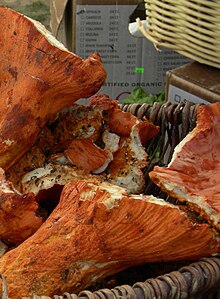Hypomyces
This article may be expanded with text translated from the corresponding article in Japanese. (November 2011) Click [show] for important translation instructions.
|
| Hypomyces | |
|---|---|

| |
| Hypomyces lactifluorum | |
| Scientific classification | |
| Kingdom: | Fungi |
| Division: | Ascomycota |
| Class: | Sordariomycetes |
| Order: | Hypocreales |
| Family: | Hypocreaceae |
| Genus: | Hypomyces (Fr.) Tul. & C. Tul. (1860) |
| Type species | |
| Hypomyces lactifluorum (Schwein.) Tul. & C. Tul.
| |
Hypomyces is a genus of parasitic ascomycete fungi found in Europe, North America, Australia, and parts of China. The genus contains 53 species.[1] Better known species include the lobster mushroom (Hypomyces lactifluorum) and the bolete eater (Hypomyces chrysospermus).
List of noteworthy species[]
- H. cervinigenus - on Helvella lacunosa.[2]
- H. chrysospermus - Bolete Eater, Cask fungus (Eurasia, Western Australia, North America)
- H. hyalinus - Amanita "mold" (North America)
- H. lactifluorum - Lobster mushroom (North America)
- - Yellow-green Russula "mold" (North America)
- - Ramaria Eater (North America)
Ecology and shape[]
All Hypomyces species live by infesting other fungi. The hypomyce fungi itself is not very conspicuous, and generally presents as a scab of only 1 mm in diameter and height. In many cases, this fruiting body grows on the fruiting body of another fungus that has become the host, and changes the form and color of the host to something different from the original.
The individual fungi bodies are finely grained, and many of them exhibit long, narrow ellipsoids under magnification. Their diameter and height are usually about 1 to 2 mm. In general, hyphae are spread on the surface of a host fruit body and buried in the mycelium to form a large number of fruiting bodies. These can be yellow, white, olive, tan, pink or red, and present within the host or in the hypha mat.
Within the individual Ascomycete fungi, spore sacs known as asci are formed. Asci have an elongated cylindrical shape, and has a dome-shaped structure called a “cap” at the tip. Ascospores are formed, then ejected from the tip of the fruit body to the outside world.
Spores generally have a slightly angular ellipsoid shape, and in many species they are separated by a single partition, usually exhibiting a colorless to pale yellow color, and the cell walls are thick with warts or humps on the surface.
Life cycle[]
Most species reproduce asexually. Asexual regeneration spores are generally called thick-wall spores, as they have thick cell walls. Unfortunately, the precise mechanisms of spore reproduction, specifically the methods used to find and infest hosts is largely unknown.
Hosts[]
The fungi generally prefers terrestrial mushrooms such as the genera Amanita, Agaricus, Chichitake, Numeriiguchi and Awotake.
If the host is a wood ear mushroom, the fungi produces a colloidal fruiting body
Many agaric mushrooms, when used as a host, do not develop properly and become malformed
Distribution[]
Species of Hypomyces have been found in Europe, North America, Australia, and parts of China. There are at least 19 species recorded in Japan.
Other species[]
References[]
- ^ Kirk PM, Cannon PF, Minter DW, Stalpers JA (2008). Dictionary of the Fungi (10th ed.). Wallingford, UK: CAB International. p. 373. ISBN 978-0-85199-826-8.
- ^ Arora, David (1986). Mushrooms demystified: a comprehensive guide to the fleshy fungi (2nd ed.). Berkeley: Ten Speed Press. pp. 815–16. ISBN 0-89815-169-4.
External links[]
![]() Media related to Hypomyces at Wikimedia Commons
Media related to Hypomyces at Wikimedia Commons
- Sordariomycetes genera
- Parasitic fungi
- Hypocreaceae
- Science articles needing translation from Japanese Wikipedia
- Taxa named by Elias Magnus Fries
- Hypocreales stubs